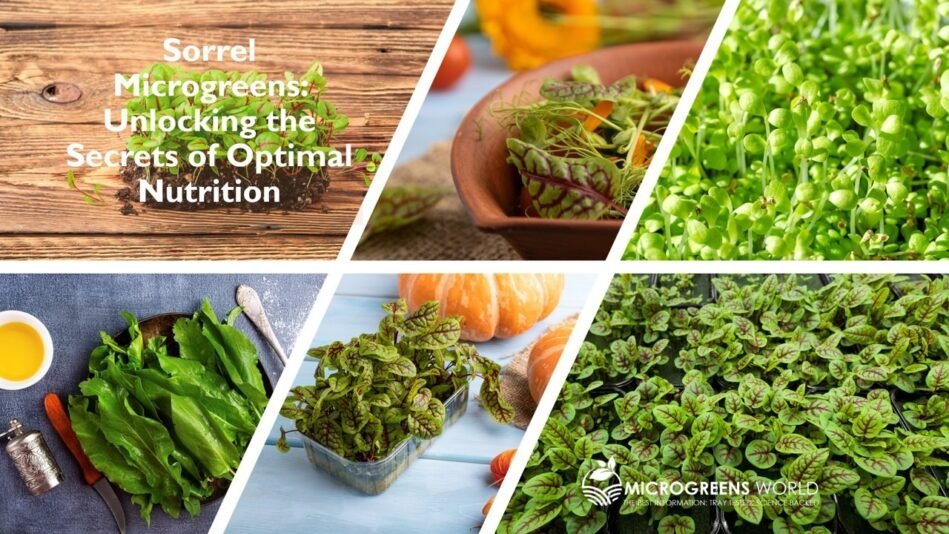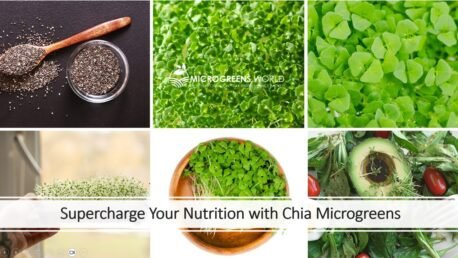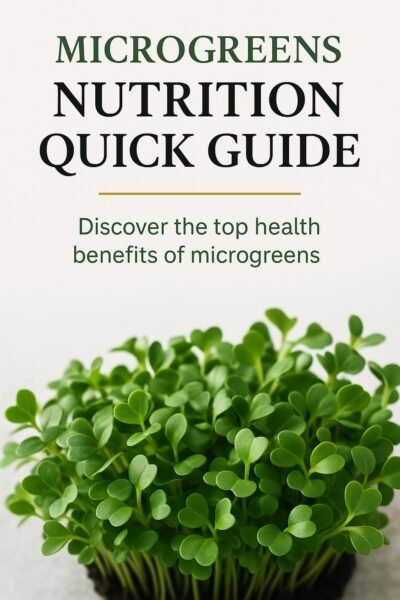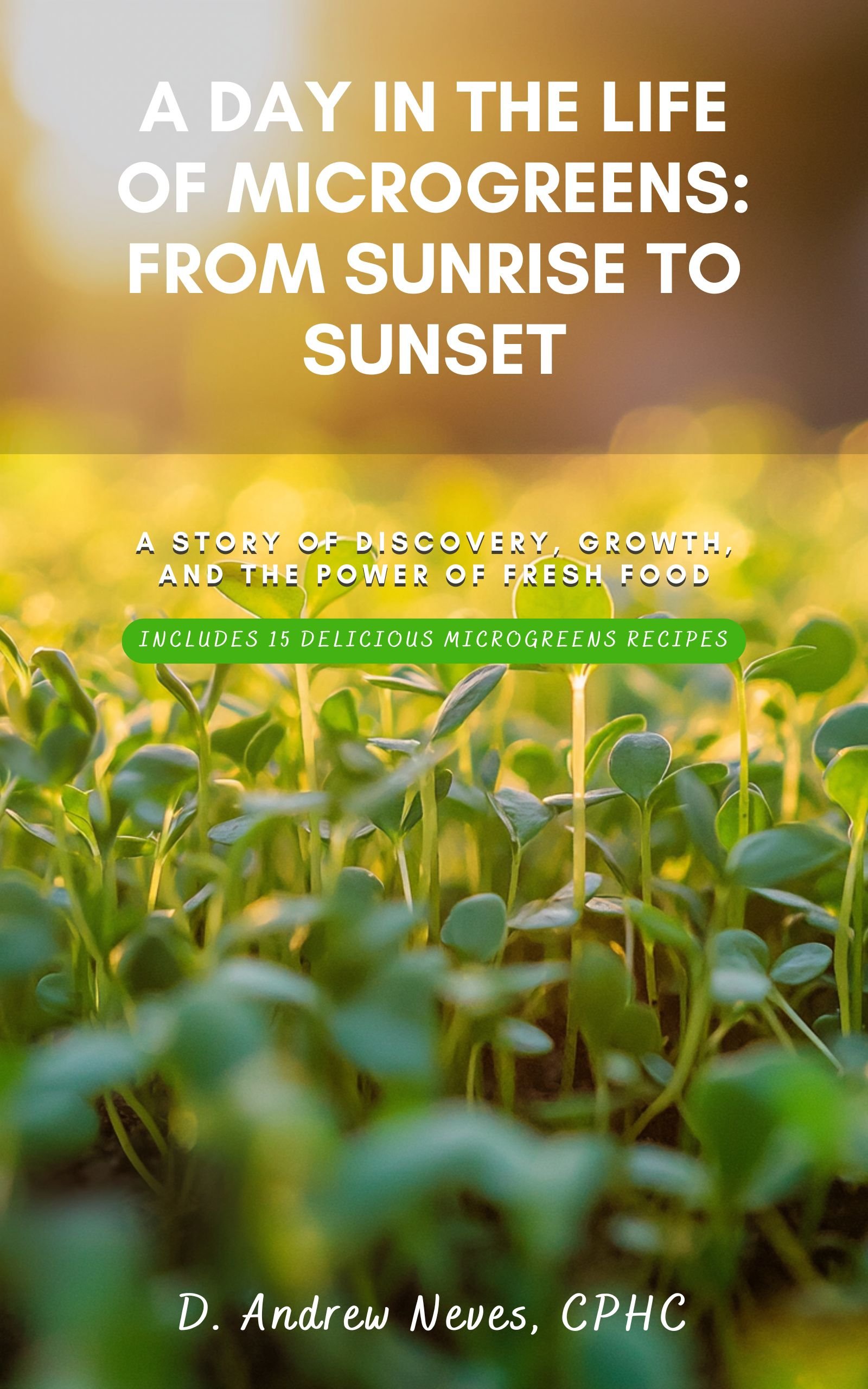I love visiting my friends, and last weekend I visited a friend who recently moved to live permanently out of town. I was curious about his reason for moving; he told me he needed some quiet place with enough space to grow sorrel, his favorite microgreens. I had never heard of sorrel microgreens before and was interested in knowing more about them.
Sorrel microgreens are rich in essential vitamins C (53.33%) and A (22.22%), with moderate amounts of minerals iron (13.33%), magnesium (24.52%), copper (14.56%), and manganese (15.17%). In addition to vitamins and minerals, sorrel microgreens are a rich source of antioxidants having eight of the nine essential amino acids, only lacking in tryptophan. It is also a moderate source of fiber (10.36%).
In this post, we will delve into the wonders of sorrel microgreens, exploring their distinctive characteristics and nutritional value.
Key Takeaways
- Sorrel microgreens deliver exceptional vitamin C (53.33%) and vitamin A (22.22%) for immune and vision support.
- Contains essential minerals including magnesium (24.52%), manganese (15.17%), copper (14.56%), and iron (13.33%) for overall health.
- Provides eight of nine essential amino acids, lacking only tryptophan, plus moderate fiber (10.36%) for digestion.
- Features a distinctive, tangy, lemony flavor perfect for salads and soups, adding refreshing zest to culinary dishes.
- Thrives in cooler temperatures with indirect light, making them ideal for easy indoor cultivation year-round.
INTERESTED IN MICROGREENS?
Join the community
Join more than 50,000 other health-conscious individuals and couples who visit our site and receive weekly emails from us to help them grow more microgreens to live healthier and longer lives.
Understanding Sorrel Microgreens
Sorrel Microgreens: Nutritional Analysis
Health Benefits of Sorrel Microgreens
Cooking with Sorrel Microgreens
Types of Sorrel Microgreens
Growing Sorrel Microgreens: Unique Conditions
Sorrel Microgreens Nutrition: Key Insights
Related Questions
Share the Guide
References
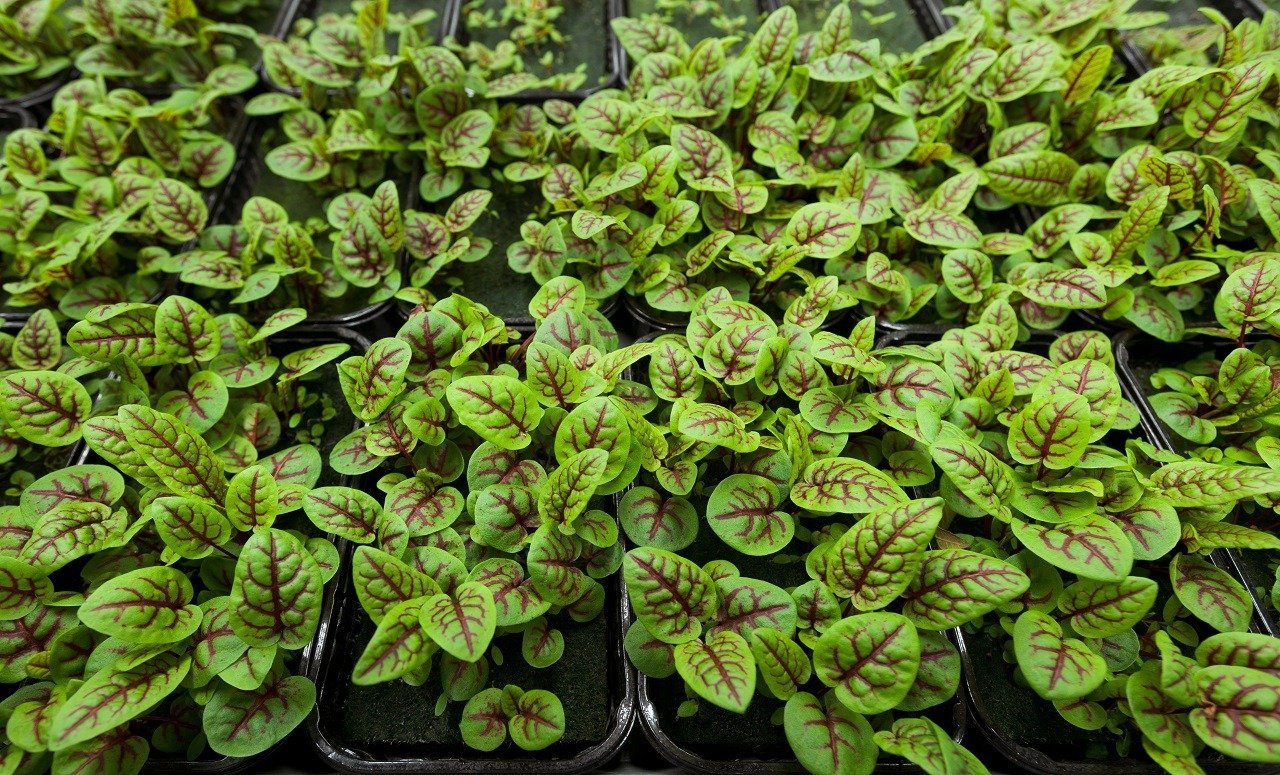
Understanding Sorrel Microgreens
The prestigious Rumex acetosa has spread throughout the world, naturalizing in many regions of North America, Europe, Africa, and Asia. It is assumed to have come from European or Asian origin. This widespread distribution is a testament to the plant’s adaptability and its enduring appeal to both growers and gastronomes.
Throughout history, Rumex acetosa has been valued for its subtle flavor, and it has been used in medicinal and culinary preparations, particularly in soups, salads, and sauces.
| Scientific Name | Rumex acetosa |
| Common Name | Sorrel, garden sorrel, sour dock |
| Plant Family | Polygonaceae (dock family) |
| Etymology | The word “sorrel” comes from the Old French word “sorele,” which means “sour.” This is about the sour taste of the leaves of sorrel plants. |
The scientific name for sorrel plant is Rumex acetosa. The Rumex genus has more than 200 herb species that are annual, biennial, and perennial. While some are destructive weeds, others are used as food and medicine. The most common edible Rumex species is R. acetosa. Still, the French sorrel (R. scutatus), which is less acidic, is preferred by chefs for their culinary activities.
The Rumex genus has more than 200 herb species that are annual, biennial, and perennial.
Sorrel has a rich history in traditional medicine. Its medicinal properties have been recognized and utilized by different cultures throughout history. Ancient Greeks and Romans used sorrel to remedy digestive disorders, including indigestion and constipation. It was also used as a diuretic and to relieve fevers.
In addition to its culinary uses, Rumex acetosa has a long history of medicinal use. [1] In traditional medicine, the plant has been employed as a digestive aid, diuretic, and blood purifier. It has also been used to treat various ailments, including scurvy, fever, and skin conditions. [2]
Sorrel microgreens, the delightful and delicate young shoots of the sorrel plant, possess a captivating vibrancy with their tender, verdant leaves. These remarkable greens are harvested at an early stage of growth, typically within 7 to 21 days after germination, when their first true leaves emerge; when they reach a height of around 1-3 inches, boasting a vibrant green hue that is both visually appealing and enticing to the palate.
Polyphenols, associated with various health benefits, such as improving heart function and reducing the risk of cardiovascular disease, are contained in sorrel microgreen. Flavonoids, another group of antioxidants found in sorrel microgreens, have anti-inflammatory properties that can help alleviate inflammation. Quercetin, a specific flavonoid in sorrel microgreens, is known for its anti-allergic and anti-inflammatory properties.
While mature sorrel plants are renowned for their tangy and slightly sour taste, sorrel microgreens offer a more nuanced and gentle flavor profile, making them an exquisite addition to a wide range of culinary creations.
Today, sorrel is cultivated and consumed in various parts of the world. It is grown in Europe, North America, Asia, and Africa. Different varieties of sorrel are used in different cuisines, and its tangy flavor continues to be appreciated in various dishes, including salads, soups, sauces, and beverages.
There are hundreds of plants, herbs, roots, and fruits you can grow and eat as microgreens. Explore my post “Top 30 Microgreens You Can Easily Grow Indoors.”
Sorrel Microgreens: Nutritional Analysis
Don’t let their size deceive you; sorrel microgreens boast an impressive nutritional profile surpassing its fully-grown vegetable. They are a treasure trove of essential vitamins, minerals, and antioxidants vital for maintaining overall health and well-being. Below is a breakdown of nutrients found in 100g of sorrel.[3]
| Name | Amount | Daily Value | %Daily Value |
|---|---|---|---|
| Water | 93 g | ||
| Energy | 22 kcal | ||
| Energy | 92 kJ | ||
| Protein | 2 g | 50 g | 4.00% |
| Total lipid (fat) | 0.7 g | 78 g | 0.90% |
| Ash | 1.1 g | ||
| Carbohydrate, by difference | 3.2 g | 275 g | 1.16% |
| Fiber, total dietary | 2.9 g | 28 g | 10.36% |
| Calcium, Ca | 44 mg | 1300 mg | 3.38% |
| Iron, Fe | 2.4 mg | 18 mg | 13.33% |
| Magnesium, Mg | 103 mg | 420 mg | 24.52% |
| Phosphorus, P | 63 mg | 1250 mg | 5.04% |
| Potassium, K | 390 mg | 4700 mg | 8.30% |
| Sodium, Na | 4 mg | 2300 mg | 0.17% |
| Zinc, Zn | 0.2 mg | 11 mg | 1.82% |
| Copper, Cu | 0.131 mg | 0.9 mg | 14.56% |
| Manganese, Mn | 0.349 mg | 2.3 mg | 15.17% |
| Selenium, Se | 0.9 µg | 55 mcg | 1.64% |
| Vitamin C, total ascorbic acid | 48 mg | 90 mg | 53.33% |
| Thiamin | 0.04 mg | 1.2 mg | 3.33% |
| Riboflavin | 0.1 mg | 1.3 mg | 7.69% |
| Niacin | 0.5 mg | 16 mg | 3.13% |
| Pantothenic acid | 0.041 mg | 5 mg | 0.82% |
| Vitamin B-6 | 0.122 mg | 1.7 mg | 7.18% |
| Folate, total | 13 µg | 400 mcg | 3.25% |
| Vitamin A, RAE | 200 µg | 900 mcg | 22.22% |
| Vitamin A, IU | 4000 IU | ||
| Threonine | 0.094 g | ||
| Isoleucine | 0.102 g | ||
| Leucine | 0.167 g | ||
| Lysine | 0.115 g | ||
| Methionine | 0.035 g | ||
| Phenylalanine | 0.114 g | ||
| Tyrosine | 0.083 g | ||
| Valine | 0.133 g | ||
| Arginine | 0.108 g | ||
| Histidine | 0.054 g | ||
| Alanine | 0.132 g | ||
| Aspartic acid | 0.181 g | ||
| Glutamic acid | 0.216 g | ||
| Glycine | 0.114 g | ||
| Proline | 0.116 g | ||
| Serine | 0.077 g |
Table: Sorrel microgreens nutrition facts
Nutrients Found in Sorrel Microgreens
As you can see, sorrel is a very nutrient-dense food. It is a good source of vitamins C and A and iron, calcium, manganese, and magnesium. Below are some of the nutrients explained:
| Vitamins | |
| Vitamin C | This powerful antioxidant is crucial in collagen production, skin health, and iron absorption. And sorrel gives you more than 50% of your DRV. |
| Vitamin A | Essential for vision, immune function, and healthy skin and mucous membranes. |
| Minerals | |
| Iron | Vital for oxygen transportation throughout the body, preventing anemia and fatigue. |
| Copper | An essential trace mineral plays a significant role in many vital functions of the internal organs – absorption of iron, formation of collagen and synthesis of neurotransmitters. |
| Magnesium | In addition to energy production, protein synthesis, muscle contraction, and nervous system control are essential in over 300 biological reactions within the body. |
| Manganese | An essential trace mineral with a role in many vital physiological functions, such as energy production, bone health, and protection against oxidants. |
| Antioxidants and Phytochemicals | |
| Polyphenols | These micronutrients act as antioxidants, neutralizing free radicals and protecting cells from damage. |
| Flavonoids | These are known for their anti-inflammatory and immune-modulating properties. |
| Quercetin | A type of flavonoid that exhibits anti-allergic and anti-inflammatory effects, contributing to overall well-being. |
| Other | |
| Fiber | An essential carbohydrate the body cannot digest is vital in digestion, weight management, and colon cancer prevention.[4] |
Table 2. Nutrients in Sorrel Microgreens
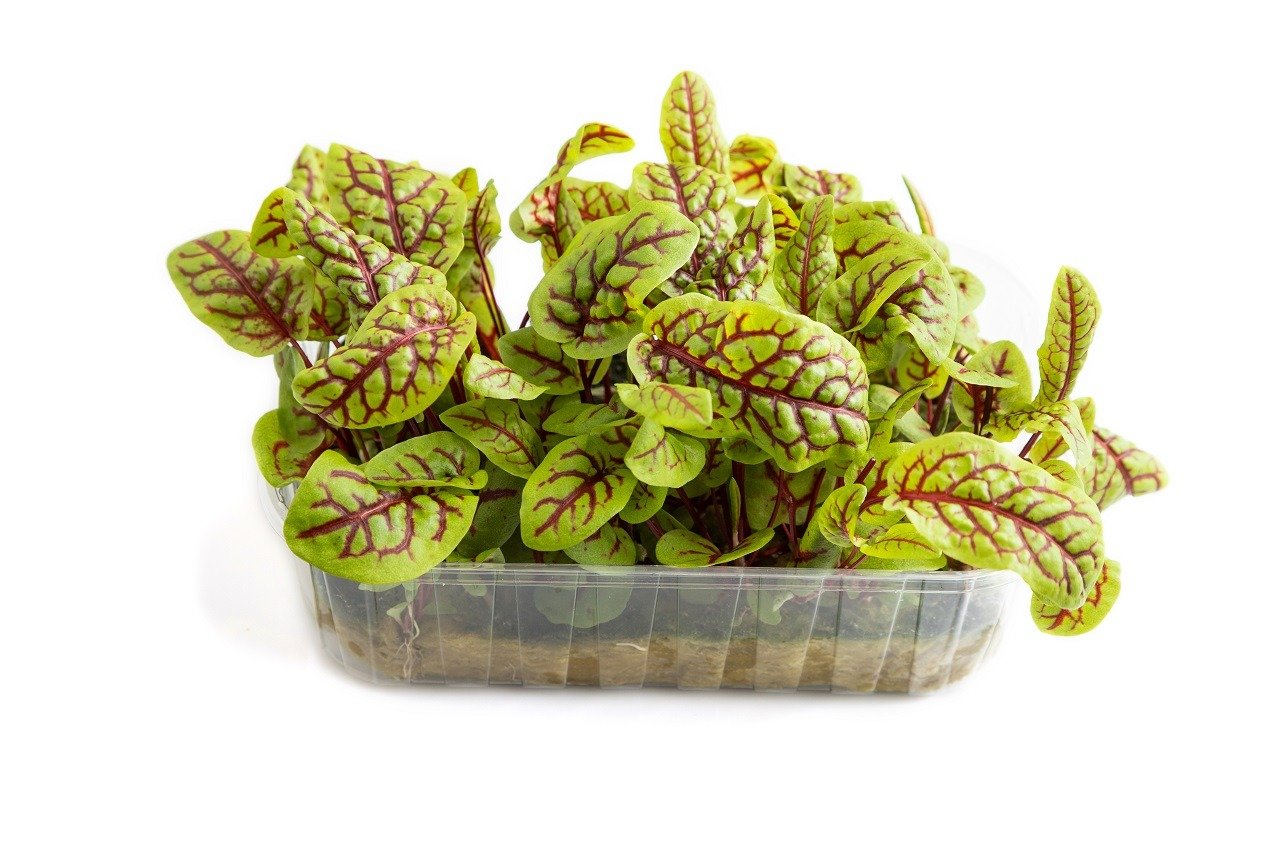
Health Benefits of Sorrel Microgreens
Sorrel microgreens offer a range of health benefits that make them a valuable addition to your diet. Here are some key benefits to consider:
| Powerful Antioxidants | One of the sorrel microgreens’ most remarkable aspects is their antioxidant content. These tiny greens contain a significant amount of polyphenols, flavonoids, and quercetin, essential for eliminating dangerous free radicals and reducing oxidative stress in the body. Sorrel microgreens can stop oxidative damage and have a vital role in preventing serious diseases like heart disease and certain types of cancer. [5] |
| Immune System Support | Thanks to their high vitamin C content, sorrel microgreens can bolster your immune system. Vitamin C prevents infections, promotes the production of white blood cells, and plays a significant role in immunosuppressant function. You can strengthen your body’s natural defense mechanisms by including sorrel microgreens in your diet.[6] |
| Cardiovascular Health | The combination of vitamins A and C and other nutrients found in sorrel microgreens supports cardiovascular health. These antioxidants help reduce heart disease by protecting the heart and blood vessels from oxidative damage. Additionally, sorrel microgreens’ potassium content helps regulate blood pressure, further promoting cardiovascular well-being. [7][8] |
| Digestive Health | Sorrel microgreens are a beneficial source of food fiber, indispensable to your digestive system’s health. Fiber promotes regular bowel movements, prevents constipation, and supports overall gut health. You can contribute to better digestion and a balanced gut microbiome by including sorrel microgreens in your meals.[9] |
| Blood Sugar Management | Individuals who wish to control their blood sugar level may benefit from using sorrel microgreens in a diet. The potassium content in sorrel microgreens helps regulate blood glucose levels, which is particularly beneficial for individuals with diabetes or those at risk of developing the condition.[10] |
Please note that while chia microgreens have many potential health benefits, it’s essential to consume them as part of a balanced diet and not rely on them as the sole treatment for any medical conditions. Always consult with your primary healthcare professional before making any changes in your diet.

Cooking with Sorrel Microgreens
| Adding them to Salads, Sandwiches, and Wraps | Toss a handful of sorrel microgreens into your favorite salads, sandwiches, or wraps for an extra burst of flavor and nutrition. The mild tangy taste adds a refreshing element to your meals. [11] |
| Blending them into Smoothies | Mix sorrel microgreens into your favorite smoothie recipes. They provide vibrant green color and a tangy kick that complements the sweetness of fruits. [12] |
| Using them as a Garnish or Topping | Sprinkle sorrel microgreens on top of soups, omelets, or roasted vegetables to elevate the visual appeal and add a zesty touch. |
Want more ideas on using radish and other microgreens in your daily meals? Read my post, “Mastering the Art – How Chefs Pair Microgreens with Proteins for a Nutritional Boost.“
Types of Sorrel Microgreens
There are several types of sorrel, each with its unique characteristics and culinary uses. Here are some popular types of sorrel [13]:
| Common Sorrel (Rumex acetosa) | Also known as garden sorrel or spinach dock, common sorrel is the most widely cultivated and used variety. It has bright green leaves that are arrow-shaped or elongated. The common sorrel has a sweet, lemony flavor, making it an ideal addition to salads, soups, and sauces. |
| French Sorrel (Rumex scutatus) | French sorrel, also called buckler-leaved sorrel, has small, shield-shaped leaves often used in culinary preparations. It has a milder, less acidic flavor than common sorrel, making it suitable for salads and garnish. |
| Red-veined Sorrel (Rumex sanguineus) | Red-veined sorrel is known for its vibrant, dark green leaves with striking red veins. It adds color to the dishes and has a tangy, mildly sour taste. Red-veined sorrel is often used in salads, sandwiches, and garnish. |
| Sheep’s Sorrel (Rumex acetosella) | Sheep’s sorrel, also called field sorrel or sour grass, has small, arrow-shaped leaves and a more intense sour taste than other sorrel varieties. It is often used sparingly as a flavoring herb in dishes like salads, soups, and sauces. It is also used in traditional herbal remedies for its purported medicinal properties. |
| Wood Sorrel (Oxalis spp.) | Wood sorrel is a different plant genus but is sometimes referred to as sorrel due to its similar sour taste. It has delicate, clover-like leaves and comes in various species, including Oxalis acetosella and Oxalis stricta. Wood sorrel is often used in salads, beverages, and desserts. |
These examples are just a few of the many types of sorrel available. The specific variety of sorrel may vary based on the region and availability. Each type of sorrel has its distinct flavor profile, allowing for various culinary applications and adding a tangy, refreshing taste to dishes.
Growing Sorrel Microgreens: Unique Conditions
Growing sorrel microgreens at home is easy. However, sorrel microgreens prefer cooler temperatures and indirect light, making them ideal for indoor cultivation in cooler climates or colder months. Here’s a brief overview of the unique growing conditions within the production lifecycle:
| Seed Sourcing and Sanitization | Sorrel seeds, sourced from specialized suppliers, are tiny and require careful handling. They are sanitized using a specific solution to eliminate potential pathogens. |
| Planting | These seeds are sown densely on a growing medium like coconut coir or peat moss. They require a shallow planting depth, unique to other microgreens, and a consistent temperature and high humidity. |
| Germination | Sorrel seeds have a more extended germination period, typically 7-14 days. They require a consistent temperature of around 20-22°C (68-72°F) and high humidity. |
| Growing | Sorrel microgreens prefer indirect light and cooler temperatures and grow slower than many other microgreens, taking up to 21-28 days to reach the harvesting stage. |
| Temperature | Sorrel microgreens thrive in cool temperatures for optimal growth. Grow sorrel microgreens in an optimal temperature between 60 and 70F, 15 to 21C. |
| Storage | Sorrel microgreens are best stored at low temperatures (around 4°C/39°F) in high humidity conditions. They have a shorter shelf life compared to other microgreens. |
| Distribution | Due to their short shelf life, sorrel microgreens are often sold locally or used immediately in restaurants. |
Please note that the conditions can vary based on the specific variety of sorrel and the growing environment.
Explore sustainable microgreens farming in my post, “The Complete Guide to Organic Microgreens Farming: For Home Gardeners and Entrepreneurs.”
Sorrel Microgreens Nutrition: Key Insights
Throughout this guide, we’ve explored sorrel microgreens, examining their nutritional composition, health benefits, culinary applications, and unique growing conditions.
Sorrel microgreens are a true nutritional powerhouse, offering an array of vitamins, minerals, and antioxidants. Here are the key takeaways.
Sorrel microgreens are a rich source of vitamins A and C and essential minerals like iron, magnesium, and copper. They also contain significant dietary fiber, contributing to a balanced diet.
Consuming sorrel microgreens can support heart health, boost immunity, improve digestion, and contribute to overall well-being. Their high antioxidant content helps combat oxidative stress, promoting cellular health.
Sorrel microgreens add a unique, tangy flavor to a variety of dishes. They can be used in salads, soups, sandwiches, or garnishes with a fresh, bright taste.
Sorrel microgreens prefer cooler temperatures and indirect light, making them ideal for indoor cultivation in cooler climates or colder months.
Whether you’re a home gardener, urban dweller, gourmet chef, or health-conscious consumer, sorrel microgreens offer a nutritious and flavorful addition to your meals. Start your sorrel microgreens journey today!
Related Questions
How do sorrel microgreens taste?
Sorrel microgreens have a distinct tangy and slightly tart flavor. They are often described as having a lemony or citrusy taste, which adds a refreshing and zesty element to dishes. Explore microgreens taste in my post, “What Do Microgreens Taste Like?”
How are sorrel microgreens different from mature sorrel plants?
Sorrel microgreens are sorrel plants’ young and tender shoots, harvested at an early growth stage. In comparison, mature sorrel plants have larger leaves and a more pronounced tartness. Explore more in my post, “Shopping Bag Choices: Microgreens vs. Vegetables.”
Can sorrel microgreens be frozen or stored for later use?
It is best to consume fresh sorrel microgreens to retain flavor and nutritional value. They do not freeze well, and their delicate texture may be compromised during freezing and thawing. Explore more in my post, “How Long Can You Store Microgreens at Home?”
If you want more in-depth information, contact Andrew Neves at andrew.neves@microgreensworld.com.
Share the Guide
I hope you enjoyed this guide to the nutritional benefits of sorrel microgreens. If you found this information helpful, please share this post on social media. You can also sign up for our newsletter to stay updated on our latest posts.
And if you’re interested in learning more about microgreens, check out our other posts on the topic. We have a wide variety of articles on microgreens, including how to grow them, how to use them in recipes, and the health benefits of microgreens.
Thanks for reading!
- For a wealth of knowledge, read the post “The Beginner’s Nutritional Guide to Incredible Microgreens” to explore more about microgreens.
- Discover how to grow microgreens. Read this post, “Beyond the Windowsill: Growing Microgreens on Your Balcony or Patio.“
- Interested in the business side? “Harnessing Technology for a Greener Future: A Guide for Microgreens Entrepreneurs.”
INTERESTED IN MICROGREENS?
Join the community
Join more than 50,000 other health-conscious individuals and couples who visit our site and receive weekly emails from us to help them grow more microgreens to live healthier and longer lives.
References
- Korpelainen, H., Pietiläinen, M. Sorrel (Rumex acetosa L.): Not Only a Weed but a Promising Vegetable and Medicinal Plant. Bot. Rev. 86, 234–246 (2020). https://doi.org/10.1007/s12229-020-09225-z
- Scientific classification and etymology – hamilton college. (n.d.-b). https://academics.hamilton.edu/foodforthought/Our_Research_files/sorrel.pdf
- FoodData Central. (n.d.-b). https://fdc.nal.usda.gov/fdc-app.html#/food-details/170076/nutrients
- Yanes-Molina, A. P. (2019). Microgreens – an alternative to horticultural production and market. http://www.zbw.eu/econis-archiv/handle/11159/4595
- Vasas A, Orbán-Gyapai O, Hohmann J. The Genus Rumex: Review of traditional uses, phytochemistry, and pharmacology. J Ethnopharmacol. 2015 Dec 4;175:198-228. doi: 10.1016/j.jep.2015.09.001. Epub 2015 Sep 14. PMID: 26384001.
- Carr AC, Maggini S. Vitamin C, and Immune Function. Nutrients. 2017 Nov 3;9(11):1211. doi: 10.3390/nu9111211. PMID: 29099763; PMCID: PMC5707683.
- Qamar HM, Qayyum R, Salma U, Khan S, Khan T, Shah AJ. Vascular mechanisms underlying the hypotensive effect of Rumex acetosa. Pharm Biol. 2018 Dec;56(1):225-234. doi:10.1080/13880209.2018.1446031. PMID: 29560776; PMCID: PMC6130607.
- Soliman GA. Dietary Fiber, Atherosclerosis, and Cardiovascular Disease. Nutrients. 2019 May 23;11(5):1155. doi: 10.3390/nu11051155. PMID: 31126110; PMCID: PMC6566984.
- Rd, R. A. M. (2021, August 12). Sorrel: Nutrients, Benefits, Downsides, and Recipes. Healthline. https://www.healthline.com/nutrition/sorrel-benefits#what-is-it
- Akbar, A. (2023, May 1). High Fiber Diet. StatPearls – NCBI Bookshelf. https://www.ncbi.nlm.nih.gov/books/NBK559033/
- Jarić, S, Z. Popović, M. Mačukanović-Jocić, L. Djurdjević, M. Mijatović, B. Karadžić, M. Mitrović & P. Pavlović. 2007. An ethnobotanical study on the usage of wild medicinal herbs from Kopaonik Mountain (Central Serbia), Journal of Ethnopharmacology 111: 160-175.
- Qureshi, R. A., M. A. Ghufran, K. N. Sultana, M. Ashraf & A. G. Khan. 2007. Ethnomedicinal studies of medicinal plants of Gilgit district and surrounding areas. Ethnobotany Research Applications 5: 115–122.
- Britannica, T. Editors of Encyclopaedia (2022, May 29). sorrel. Encyclopedia Britannica. https://www.britannica.com/plant/sorrel
- “Rumex Acetosa Sorrel, Garden Sorrel PFAF Plant Database.” Pfaf.org, https://pfaf.org/user/plant.aspx?LatinName=Rumex+acetosa.
